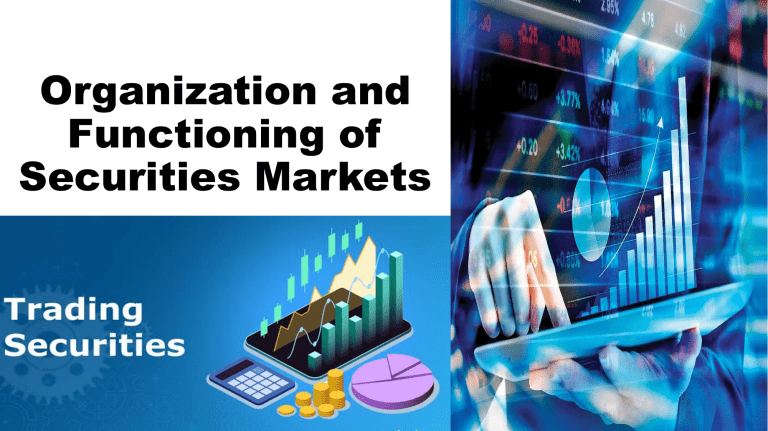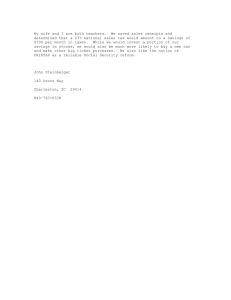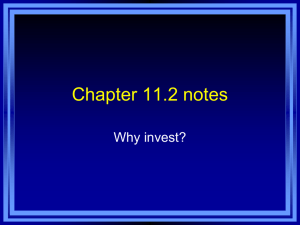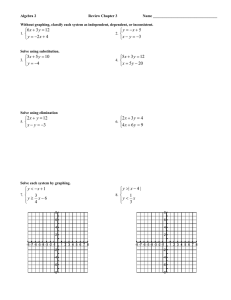
Organization and Functioning of Securities Markets WHAT IS A MARKET? A market is the means through which buyers and sellers are brought together to aid in the transfer of goods and/or services. Characteristics of a Good Market 1. Timely and accurate information on the price and volume of past transactions. 2. Liquidity, meaning an asset can be bought or sold quickly at a price close to the prices for previous transactions (has price continuity), assuming no new information has been received. In turn, price continuity requires depth. 3. Low transaction costs, including the cost of reaching the market, the actual brokerage costs, and the cost of transferring the asset. 4. Prices that rapidly adjust to new information, so the prevailing price is fair since it reflects all available information regarding the asset. PRIMARY CAPITAL MARKETS The primary market is where new issues of bonds, preferred stock, or common stock are sold by government units, municipalities, or companies who want to acquire new capital. Primary markets are facilitated by underwriting groups consisting of investment banks that set a beginning price range for a given security and oversee its sale to investors. Types of primary market issues • initial public offering (IPO) • a private placement • a rights issue • a preferred allotment Secondary Capital Markets The secondary market is where investors buy and sell securities they already own. It is what most people typically think of as the "stock market," though stocks are also sold on the primary market when they are first issued. Types of Secondary • An auction market- an open outcry system where buyers and sellers congregate in one location and announce the prices at which they are willing to buy and sell their securities. • A dealer market- in which participants in the market are joined through electronic networks. The dealers hold an inventory of security, then stand ready to buy or sell with market participants. Philippine Stock Exchange (PSE) The Philippine Stock Exchange is a marketplace wherein investors can buy or sell stocks of publicly listed companies. However, you cannot just walk into PSE’s office and purchase stocks in exchange for cash. You need to open a stock trading account with a PSE accredited stockbroker. You have the option to choose between a traditional and online stockbroker. Different stockbrokers have different commission rates ranging from 0.25%-1.50% for every transaction. (www.timson.com.ph) What are stocks? Stocks are shares of ownership in a corporation. The stock market is a place where stocks are bought and sold. The Philippine Stock Exchange (PSE) is the corporation that governs our local stock market. People buy or invest in stocks to benefit from a company's tremendous value potential over time. Once you buy or invest into a stock you now become part owner or a shareholder of that particular corporation. Why Invest in the Stock Market? History has proven that investing in quality stocks can provide greater returns than most investment instruments. This offers you the best chance in achieving your financial goals and gives you the ability to later enjoy the benefits of your money working for you. (colfinancial.com) The 4 Golden Rules 1. Invest EARLY- Invest early to take advantage of compounding over a greater period of time. 2. Invest REGULARLY- Invest regularly add the same amount into your investment. 3. Invest LONG TERM- Long term investing solves the problem of short-term volatility (choppiness in price) 4. Invest using DIVERSIFICATION- The management of risk should always come hand-in-hand with your choice of investment. One way of containing risk is through diversifying or by spreading investments around and away from one single asset class. "Do not put all your eggs in one basket." Security Market Indexes A security market index is a means to measure the growth of value of a set of securities. USES OF SECURITY-MARKET INDEXES A primary application is to use the index values to compute total returns and risk measures for an aggregate market or some component of a market over a specified time period. Example of stock indexes: • Dow Jones Industrial Average (DJIA) • S&P 500 Index • Bloomberg U.S. Aggregate Bond Index DIFFERENTIATING FACTORS IN CONSTRUCTING MARKET INDEXES • The Sample- sample used to construct an index. The size, the breadth, and the source of the sample are all important. The sample can be generated by completely random selection or by a nonrandom selection technique designed to incorporate the important characteristics of the desired population. • Weighting Sample Members- weight given to each member in the sample. Four principal weighting schemes are used for security-market indexes: (1) a price-weighted index,(2) a market-value weighted index, (3) an unweighted index, or what would be described as an equal-weighted index, and (4) a fundamental weighted index based on some operating variable like sales, earnings, or return on equity. • Computational Procedure- The final consideration is the computational procedure used. Arithmetic mean and Geometric mean Price-Weighted Index A price-weighted index is an arithmetic mean of current stock prices, which means that index movements are influenced by the differential prices of the components.






